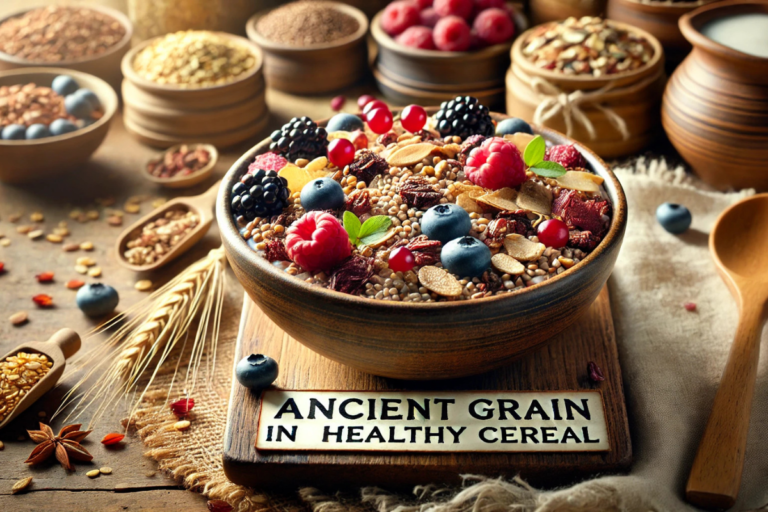Introduction to Ancient Grains in Healthy Cereals
Ancient grains are becoming a popular choice for many people who want to eat healthy. Unlike modern grains that have been heavily processed, ancient grains have remained largely unchanged over thousands of years. These grains are rich in nutrients and offer many health benefits, which is why more and more health-conscious individuals are adding them to their diet.
In recent years, the New York Times (NYT) has published articles emphasizing the importance of ancient grains. The publication has explained how these grains are not just a trend but a powerful way to eat healthier. People are now curious about adding these grains to their meals, especially breakfast cereals.
So, why all the excitement about ancient grains? It’s simple. These grains are loaded with fiber, protein, vitamins, and minerals. They help keep you full longer, provide steady energy, and support your body in many ways. “Discover why ancient grain in a healthy cereal is gaining attention, even making headlines in the NYT,” as the interest in this topic continues to grow.
Ancient grains include options like quinoa, farro, spelt, millet, and barley. Each of these grains has its own unique set of nutrients, but they all share one common benefit: promoting a healthy lifestyle. With ancient grain-based cereals becoming more available, it’s easy to start your day with a nutritious meal.
This rising interest in ancient grains has made them a focus for people who want to eat well without sacrificing taste. The New York Times has played a key role in spreading awareness, making ancient grains a hot topic in the world of healthy eating.
In the sections that follow, we will explore what ancient grains are, the benefits they provide, and how to include them in your breakfast routine. You’ll also learn why choosing a cereal made with ancient grains can be one of the best decisions for your health.
What Are Ancient Grains?
Ancient grains are grains that have been around for thousands of years and have not changed much through modern breeding. They are different from modern grains like wheat or corn, which have been heavily modified over time to increase yields or improve resistance to pests.
Ancient grains include quinoa, farro, spelt, millet, amaranth, and barley. These grains have been part of traditional diets in many cultures, from the Andes to ancient Egypt and beyond. They have been valued for their rich flavor and nutrients, making them a key part of many civilizations’ diets.
Nutritional Benefits of Ancient Grains
Ancient grains are packed with nutrients. One major benefit is their high fiber content, which helps keep your digestive system healthy. Fiber also keeps you full for longer, which can be helpful for weight management.
These grains are also rich in protein, vitamins, and minerals. Quinoa, for example, is a complete protein, meaning it contains all the essential amino acids your body needs. Other ancient grains, like farro and amaranth, are excellent sources of iron, magnesium, and calcium.
Ancient grains also contribute to heart health. Whole grains can lower cholesterol and reduce the risk of heart disease. Plus, these grains are full of antioxidants, which fight inflammation and promote overall wellness. Adding ancient grains to your diet can give your body a boost and support long-term health.
Why Ancient Grains Are Ideal for a Healthy Breakfast Cereal
Starting your day with a healthy breakfast sets the tone for the rest of the day. Ancient grains are perfect for breakfast because they are nutrient-dense. They give you energy and keep you feeling satisfied until your next meal.
Unlike traditional cereals made from refined grains, ancient grains are whole grains. Refined grains lose much of their fiber and nutrients during processing. In contrast, ancient grain-based cereals retain all the goodness nature intended. They release energy slowly, so you don’t get hungry too soon after eating. It’s a great way to stay fueled and focused throughout the morning.
Top Ancient Grains to Include in Your Breakfast Cereal
- Quinoa: This grain is a complete protein and packed with essential amino acids. It’s also high in magnesium and antioxidants.
- Farro: Farro is full of fiber and iron. It has a chewy texture and nutty flavor, making it perfect for breakfast bowls.
- Amaranth: Known for its high protein content, amaranth also supports bone health because it’s rich in calcium.
- Millet: A gluten-free option that is high in antioxidants and easy to digest.
- Barley: Barley helps lower cholesterol and supports heart health. It’s a great addition to any breakfast cereal.
The New York Times has featured some of these ancient grains in healthy recipes, showing readers how to incorporate them into their meals.
How to Choose a Healthy Cereal Made with Ancient Grains
Choosing a healthy cereal isn’t always easy. When shopping for ancient grain cereals, be sure to read the labels carefully. Avoid cereals with added sugars or artificial ingredients. Look for options with whole grains listed as the first ingredient.
You can also try making your own ancient grain cereal mix at home. Combine different grains like quinoa, millet, and barley for a healthy breakfast. Add nuts, seeds, or dried fruit to make it even more delicious.
The Environmental Impact of Ancient Grains
Ancient grains are not just good for your health; they are also good for the planet. These grains are usually more sustainable to grow than modern crops. They require less water, are more resilient to climate change, and often need fewer pesticides.
Growing ancient grains helps maintain biodiversity and improves soil health. The New York Times has highlighted the connection between ancient grains and sustainability, showing how these grains could help create a more eco-friendly food system.
Incorporating Ancient Grains into Your Diet Beyond Cereal
Ancient grains aren’t just for breakfast. You can use them in many other meals, like salads, soups, and main dishes. Try adding quinoa to your salads or using farro in a hearty soup. Millet can be a great side dish, and amaranth works well in stews or as a porridge.
If you’re short on time, you can meal-prep ancient grains in advance. Cook a big batch and store it in the fridge to use throughout the week. Many people wonder if ancient grains are gluten-free. The answer is that some, like quinoa and amaranth, are gluten-free, while others, like barley and farro, are not. Always check labels if you have dietary restrictions.
The Future of Ancient Grains in the Modern Food Industry
Ancient grains are not just a passing trend. They are becoming a big part of the food and wellness industry. More and more people want natural, nutrient-rich foods, and ancient grains fit the bill. Companies are now creating innovative products to meet this demand, from cereals to snacks made with these grains.
Publications like the New York Times have shaped the conversation around ancient grains, helping people understand their benefits. As we look to the future, it’s clear that ancient grains are here to stay. They offer a way to eat well while also taking care of our planet.
Conclusion
Incorporating ancient grains into your diet, especially through healthy breakfast cereals, is a simple yet impactful way to boost your nutrition. These grains, rich in fiber, protein, and essential vitamins, support digestion, heart health, and overall wellness. Starting your day with ancient grains provides lasting energy and keeps you full, making them a better choice than traditional, refined cereals.
Ancient grains are not only beneficial for our bodies but also for our planet. Their sustainable cultivation methods promote soil health and reduce environmental impact. As more people embrace this wholesome way of eating, ancient grains are becoming a staple in modern kitchens, supported by publications like the NYT that continue to highlight their value. So, why not give ancient grains a try and enjoy their rich flavors and incredible benefits?


